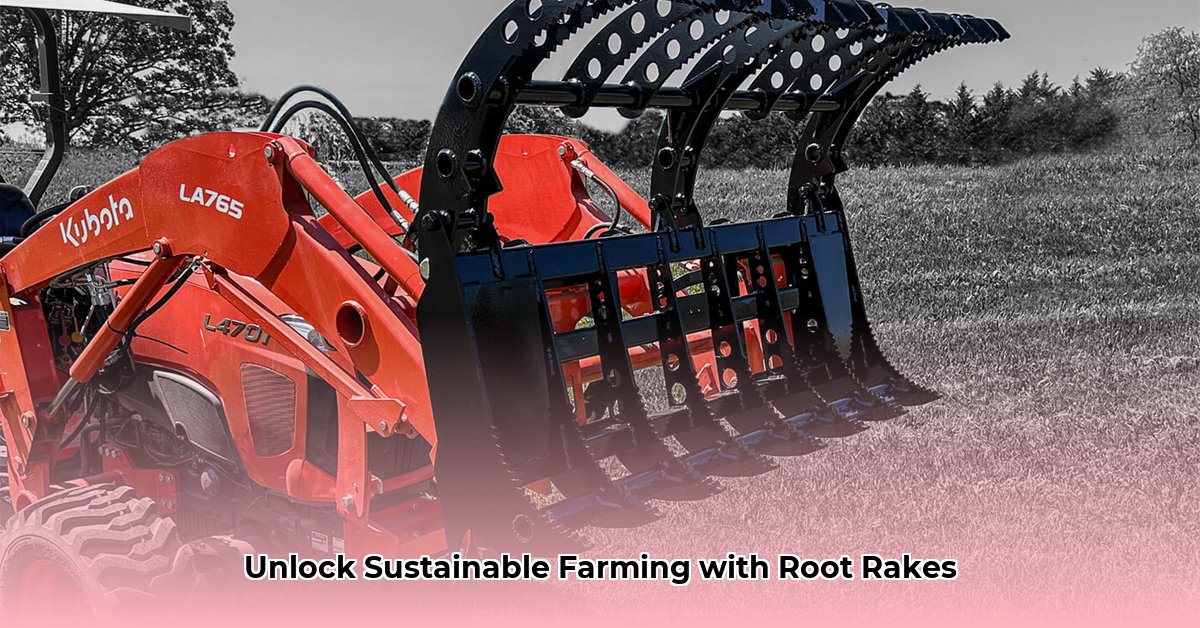
This guide provides practical instructions and insights on using tractor root rakes and grapples for efficient and sustainable land clearing. We'll cover choosing the right tool, safe operating procedures, maintenance, and the environmental benefits of these methods. For DIY options, check out this DIY tractor rake guide.
Choosing the Right Tool: Rake or Grapple?
The initial decision involves selecting between a root rake and a grapple, depending on your specific needs. This hinges on the type and size of debris you're clearing.
Root Rakes: Ideal for removing surface roots and small debris. They offer precise removal with minimal soil disturbance. However, they are less effective with large logs or heavy brush. Think of them as "fine-toothed combs" for your soil.
Grapples: Designed for handling larger obstacles like downed trees and brush. They offer powerful gripping capabilities. Grapples come in various tine lengths. Longer tines provide greater reach and power for larger debris but can be less precise and cause more soil disturbance. Shorter tines offer increased precision and maneuverability, especially in tight spaces and rocky soil.
| Tool Type | Best For | Advantages | Disadvantages |
|---|---|---|---|
| Tractor Root Rake | Removing surface roots and small debris | Precise, minimal soil disturbance, gentle on soil | Limited capacity for large debris, less versatile |
| Grapple (Long Tine) | Clearing large debris, downed trees, heavy brush | High capacity, powerful, excellent for heavy work | Can disturb more soil, less precise for root work |
| Grapple (Short Tine) | Medium-sized debris, some root removal, versatility | A good balance of capacity and precision | Might struggle with very large items or deep roots |
Tine Length Considerations: Optimal tine length is highly dependent on soil type and debris size. While precise data is limited, shorter tines generally provide better precision in rocky soil, minimizing damage to the equipment and soil. Longer tines offer greater power for larger debris removal, but can be less precise and more damaging to delicate root systems.
Mastering the Operation: A Safe Approach
Safe operation is paramount. Always prioritize safety precautions.
Pre-Operation Checks: Before starting, perform a thorough inspection. Check hydraulic fluid levels, ensure secure attachment to the tractor's three-point hitch, and verify the functionality of all safety features.
Operating Techniques: Operate at a slow and controlled pace, gradually increasing speed as needed. Adjust the rake or grapple's angle and depth to optimize performance based on the terrain and debris density. Always maintain a safe distance from moving parts.
Step-by-Step Guide (Root Rake):
- Secure Attachment: Attach the root rake securely to your tractor's three-point hitch. Double-check the connection.
- Engage PTO: Carefully engage the Power Take-Off (PTO) shaft.
- Slow and Steady: Begin at low speed and gradually increase as needed.
- Angle Adjustment: Adjust the rake's angle and depth for optimal performance based on terrain and debris density.
- Disengage Carefully: Disengage the PTO and remove the attachment safely once complete.
Grapple operation follows a similar procedure, emphasizing careful handling of heavier materials and maintaining safe distances from the moving parts.
Maintenance: An Investment in Sustainability
Proper maintenance significantly extends the lifespan of your equipment and reduces environmental impact.
High-Quality Materials: Invest in attachments made from durable materials like Hardox AR450 steel. Their superior wear resistance reduces the need for frequent replacements, promoting sustainability and long-term cost savings.
Regular Maintenance: Implement a regular maintenance schedule including cleaning, lubrication, and prompt attention to minor repairs. Prompt addressing of minor issues prevents them from becoming major problems, saving time and money.
Sustainability: Going Green While Clearing Land
Using root rakes and grapples contributes significantly to sustainable farming.
- Reduced Soil Disturbance: Minimizes soil erosion and preserves valuable topsoil compared to more aggressive clearing methods.
- Reduced Waste: Allows for composting or upcycling of removed debris, creating a closed-loop system and generating valuable compost.
- Extended Equipment Lifespan: High-quality materials and regular maintenance contribute to longer equipment life, decreasing the need for frequent replacements.
Case Studies (Illustrative Example)
A farmer using a short-tine grapple found it ideal for removing medium-sized brush and rocks from a field with varying terrain, leading to efficient clearing with minimal soil disturbance. The compost generated from the collected materials improved soil quality for future crops.
Supplier and Resource Guide
For additional information and reputable suppliers, consult:
https://agriculturegoods.com/how-to-select-the-right-grapple-for-your-tractor/ (and other relevant industry resources)